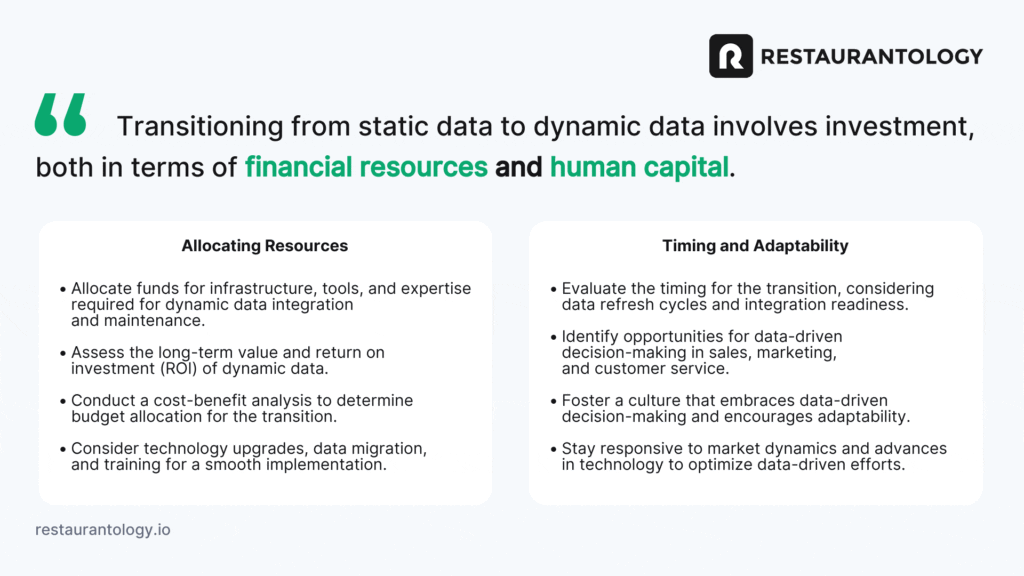Solving data decay: using integrated market intelligence to fix the problem at its source

This is the third and final blog in a 3-part series designed to help companies targeting the restaurant industry better understand, diagnose, and ultimately resolve CRM data decay. Read part one here and part two here.
In the previous two blogs, we discussed the concept of data decay and its impacts on businesses operating in a dynamic market. Now, we delve into the solution for combating data decay and unlocking the true potential of your CRM data.
Dynamic data is the future
As we’ve highlighted before, the future of CRM data lies in integration. More and more companies are recognizing the limitations of static data and the negative impact it has on their business operations. The shift towards dynamic data is gaining momentum, and it holds immense potential for improving decision-making and driving success. By eliminating static data and integrating real-time, high-quality data into your CRM, you can unlock valuable insights and stay agile in a rapidly evolving market.
Find a champion
To effectively address data decay and ensure ongoing data hygiene, it is essential to have a dedicated team member or department responsible for data management. The size and structure of your organization will absolutely determine the scope of this role.
Smaller companies may adopt an “all hands on deck” approach, while larger businesses may have specialized roles focused on data validation and ongoing ingestion. Big or small, though, you’ll want to identify a skilled data practitioner who will build and strengthen subject-matter expertise in the CRM’s data life cycle, from collection and transformation to analysis and communication. This crucial role is responsible for maintaining data integrity and driving positive outcomes. It cannot be emphasized enough.
Commit to a path forward
Once you recognize the limitations of static data and the potential of dynamic data, it’s important to commit to a clear path forward. Defining the “end-of-life” for your static data requires careful considerations, particularly in terms of budget and timing.
Transitioning from static data to dynamic data involves investment, both in terms of financial resources and human capital. It’s essential to evaluate your budget and allocate funds for the necessary infrastructure, tools, and expertise required for integrating and maintaining dynamic data. This may involve conducting a cost-benefit analysis to assess the long-term value and return on investment (ROI) of dynamic data.
Determining the right timing for the transition is also crucial. It’s important to strike a balance between the urgency to address data decay and the practicality of implementation. Considerations for timing include:
- Data refresh cycles: Evaluate the frequency at which your CRM data needs to be updated to maintain accuracy and relevance. For reference, top software players in the restaurant industry are aligning around monthly updates.
- Integration readiness: Assess your organization’s readiness to integrate dynamic data into your CRM. This includes evaluating the compatibility of existing systems, infrastructure, and data management processes. It may require technology upgrades, data migration, and training to ensure a smooth transition.
- Change management: Prepare your team for the transition from static to dynamic data. Communicate the benefits, set expectations, and provide training to ensure everyone understands the value of dynamic data and is equipped to leverage its potential. This will help mitigate resistance to change and foster a culture that embraces data-driven decision-making.
By carefully considering budget and timing, you can develop a realistic roadmap for transitioning from static data to dynamic data. This roadmap should outline the necessary steps, resources, and timelines to ensure a successful implementation.
Remember, the commitment to a path forward is not a one-time decision but an ongoing process. As technology advances and market dynamics evolve, staying adaptable and responsive to changing data needs will be crucial. Regularly reassess your data strategy, refine your approach, and leverage insights from integrated, industry-specific market intelligence partners to continually improve and optimize your data-driven efforts.
By committing to a path forward and embracing dynamic data, you position your company to thrive in an ever-changing business landscape, empowering your teams with accurate, timely information and driving growth and success.

Data activation pays dividends
By addressing data decay and embracing dynamic data, you open up new possibilities for your business. Here are a few key benefits:
- Informed, real-time decision making: Data quality is paramount for the success of a data-driven sales strategy. With dynamic data, you can ensure that your CRM is populated with accurate, up-to-date information, enabling informed decision-making and targeted sales efforts.
- Automated, ideal-state market intelligence: Understanding and targeting relevant ideal customer profiles (ICPs) is crucial in B2B sales. Dynamic data allows you to continuously update and refine prospect and customer profiles based on evolving market dynamics, enabling more effective and personalized engagement with your target audience.
- Effective collaboration and alignment: Dynamic data fosters improved collaboration and alignment between sales and marketing teams. By having access to real-time data, both teams can align their strategies, identify opportunities, and work towards shared goals more efficiently.
- Improved operational efficiency: With dynamic data, operational processes become more efficient and streamlined. Accurate and timely data helps eliminate redundant tasks, such as manual data verification or redundant data entry, freeing up valuable time for employees. By reducing manual efforts and automating routine tasks, teams can focus on higher-value activities, such as building stronger customer relationships, strategizing growth initiatives, and optimizing operational workflows. Data activation can also bring a significant boost in confidence and productivity across your organization.

Conclusion
Despite the disadvantages of static data, many B2B companies continue to rely on outdated information. No matter what data acquisition strategy you choose, the restaurant industry will continue to be a fast-paced business environment, and static data—which inherently leads to data decay—falls short in meeting the demands of a constantly changing landscape.
The significant transformations that businesses have undergone in recent years necessitate access to fresh and up-to-date market intelligence to make smart, data-driven decisions. By embracing dynamic data, you can significantly improve your sales operations, empower teams, and achieve better results at a faster pace.
Make the shift from data decay to data activation, and position your business for success in a dynamic and competitive market.


